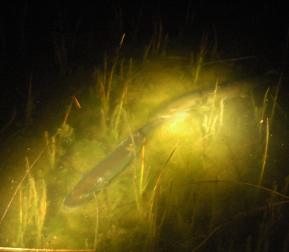Musky spawning habitat: New insights and techniques for management
Add Summary

Joe Nohner is a CSIS PhD student who's studying largemouth bass, specifically how habitat helps baby largemouth survive and grow, and the socioeconomic factors that influence landowners’ habitat management choices. He's also a passionate fisherman who aims to understand the layers and layers of complexity to solve ecosystem problems. This is an excerpt from Joe's blog, Fishing for Habitat.
Feb. 23, 2015
 Muskellunge are the largest predatory fish in Wisconsin, inspiring thousands of anglers to pursue them across their range. Yet, they are also one of the most elusive gamefish. Muskies are so few and far between that anglers only catch one every 27 hours of fishing! With such low densities, small changes can mean big differences in the populations that fishermen so zealously pursue. This is the story of how a team of researchers from the University of Michigan, the Wisconsin DNR and the Musky Clubs Alliance joined together to study these amazing fish and use new technology to improve muskellunge management.
Muskellunge are the largest predatory fish in Wisconsin, inspiring thousands of anglers to pursue them across their range. Yet, they are also one of the most elusive gamefish. Muskies are so few and far between that anglers only catch one every 27 hours of fishing! With such low densities, small changes can mean big differences in the populations that fishermen so zealously pursue. This is the story of how a team of researchers from the University of Michigan, the Wisconsin DNR and the Musky Clubs Alliance joined together to study these amazing fish and use new technology to improve muskellunge management.
Muskies prepare to spawn at night in a northern Wisconsin lake.
A major problem facing muskellunge is decreasing natural recruitment – the number of successfully hatched fish that grow to a legal size for fishing. One major bottleneck occurs during spawning, when muskellunge scatter up to 265,000 eggs apiece along the bottom of a lake or river. These eggs are fertilized by a male and hatch a few weeks later. During this time, the eggs are susceptible to poor water quality, predators, and sedimentation. Studies have shown that lakes with high human footprints -- cabins, urban development, etc. -- have lower recruitment suspected to be caused during the early stages of musky’s lives. However, the details of “preferred” muskellunge spawning habitat were poorly understood, leaving the Wisconsin DNR with difficult challenges in managing more than 350 lakes with naturally reproducing muskellunge. The agency didn’t have the manpower to conduct spawning habitat surveys on such a massive number of lakes, so they needed a way to quickly and efficiently identify spawning habitat.

More than 50 volunteers conducted spotlighting surveys to identify musky spawning habitat.
Together, we set out to better understand the spawning habitat of these fish through a series of surveys and fisheries analyses. In the early spring of 2007 and 2008, more than 50 volunteers from the Wisconsin Musky Clubs Alliance, Wisconsin DNR employees and University of Michigan students joined together to survey almost 30 lakes in northern Wisconsin. Muskies generally spawn at night, so we conducted spotlighting surveys of the shallow water on each lake. Muskellunge spawn by swimming alongside each other and then releasing the sperm and eggs simultaneously to be fertilized. As the biggest, baddest fish in the lake, they often didn’t even react to us and allowed many opportunities to view 50”-plus fish swimming directly below our boat! Using GPS units, we marked the location of each musky. We came back during the daylight and checked each GPS location for eggs to make sure that muskies were spawning at these locations.
Following that, I spent many, many, many hours staring at a computer analyzing dat



 Print
Print Email
Email









